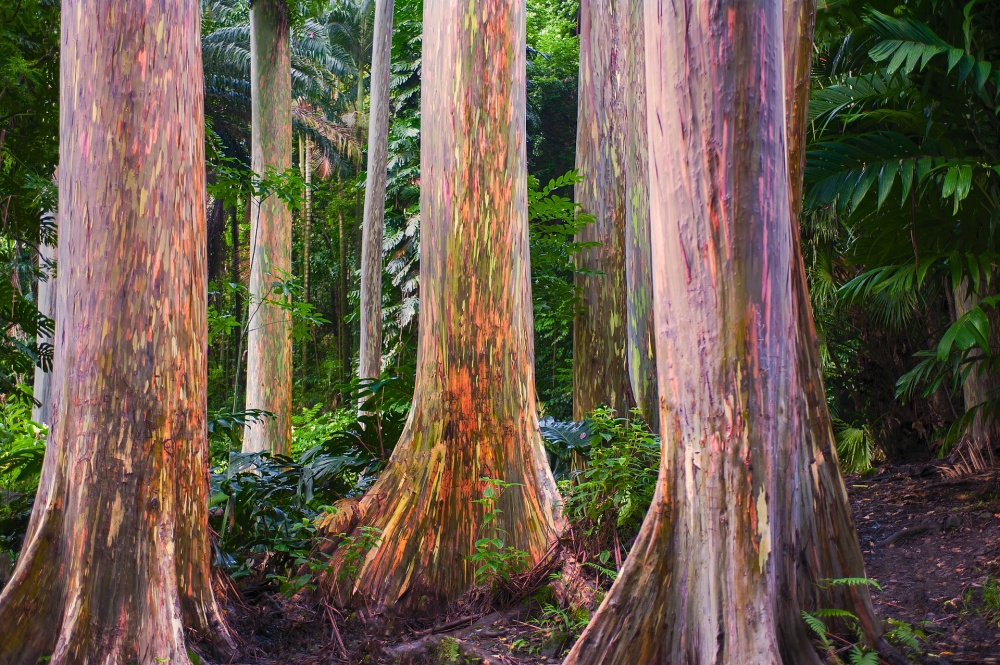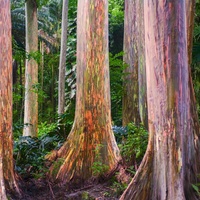Common name: Rainbow Eucalyptus
Other common names: Deglupta, Indonesian Gum, Mindanao Gum, Rainbow Gum
Description
Rainbow eucalyptus is a large timber and landscape tree originating in tropical Asia, its natural range extending from the Philippines, through Papua New Guinea, to Indonesia.
It is a fast-growing tree, averaging 1.8 m (6 ft) in height per year and can attain heights of 30 to 60 m (100 to 160 ft) in native forests, usually with a straight trunk that is branch-free for more than half the tree height and buttressed at the base on large trees. In young trees, the crown is pyramid-shaded, gradually becoming irregular with age.
The tree's most distinguishing feature is its bark, which is peeling and reveals under-bark in different shades and colours. This can range from green through blue and purple to bronze-red, depending on the amount of weathering that has occurred, creating a rainbow-like display of colours that adds to the tree's ornamental interest.
As with many eucalyptus, the leaves change shape as the tree matures, in this species from oval-shaped leaves on seedlings to long, narrow blade-like leaves on adult trees.
The flowers are small, powder-puff-like with long white filaments and bloom on and off throughout the year in small, showy clusters. The fruit that follow are bowl-shaped woody seedpods.

Photo by Designtek from Pixabay
Use
Trees from natural forests produce a medium-weight wood, averaging 700 kilograms per cubic meter (44 lbs per cubic ft), with moderate to high natural resistance to rot and decay. This contrasts with wood from plantation trees with an average weight of around 400 kilograms per cubic meter (25 lbs per cubic ft) and low natural resistance to rot and decay.
Depending on the wood source, the timber is sawn into beams for outdoor construction or into planks for indoor construction, furniture and interior joinery work. The small-diameter roundwood is chipped or pulped for particleboard and the manufacture of paper or cardboard or is cut into lengths for firewood and charcoal making.
The tree's rainbow-coloured bark gives it ornamental interest, but its planting is best suited to large parks and gardens due to its great size.
Climate
Grows naturally in humid subtropical and tropical climates, generally areas with annual lows of 13 to 25°C, annual highs of 23 to 35°C, annual rainfall of 1300 to 7000 mm and a winter dry season of 4 months or less. However, trees achieve their best development in tropical lowland areas with annual rainfall of 1800 mm or more and without a pronounced dry season.
In Papua New Guinea, Rainbow Eucalyptus can be found growing at elevations from near sea level up to 2500 m (8200 ft), in areas where the average low of the warmest month is 13°C (55°F) or above.
Growing
New plants are usually started from seed, which remain viable in storage for two years under dry, cold, air-tight conditions. Alternately, they can be started from cuttings taken from young trees.
Seedlings grow fast and can be planted in the field when around three to four months old. Best performance is on free-draining clay-loam, loam, sandy-loam and loamy-sand soils of an acid to slightly alkaline nature, generally with a pH of 5.5 to 7.5, and on sites with partial sun exposure. It has poor tolerance to drought conditions.
Problem features
The seed are small and slightly winged, enabling wind dispersal over short distances. It is assessed as a low weed risk for Hawaii and a moderate weed risk for Florida, respectively, by the Hawaii Pacific Weed Risk Assessment (HPWRA) project and the IFAS Assessment of Non-Native Plants in Florida's Natural Areas.
Rainbow Eucalyptus has a shallow root system and brittle branches, which may cause it to topple over or drop its branches in strong winds, potentially causing personal injury or damage to property. For this reason, as well as its large size, it is not recommended to plant in home gardens.
Where it grows
References
Books
-
Barwick, M., et al. 2004, Tropical & subtropical trees : a worldwide encyclopaedic guide, Thames and Hudson, London
-
Chudnoff, M. 1984, Tropical timbers of the world, Forest Service, U.S. Department of Agriculture (USDA), Washington, D.C.
-
Food and Agriculture Organization of the United Nations (FAO) 1986, Databook on endangered tree and shrub species and provenances, FAO Forestry Paper 77, Forest Resources Division, Rome
-
Francis, J. K. 1998, Tree species for planting in forest, rural, and urban areas of Puerto Rico, U.S. Department of Agriculture, Forest Service, International Institute of Tropical Forestry, Río Piedras, Puerto Rico
-
Francis, J. K. et al. 2000, Silvics of Native and Exotic Trees of Puerto Rico and the Caribbean Islands, Technical Report IITF-15, USDA Forest Service, Rio Piedras, Puerto Rico
-
Jensen, M. 1999, Trees commonly cultivated in Southeast Asia : an illustrated field guide, 2nd ed., Food and Agricultural Organisation of the United Nations (FAO) Regional Office for Asia and the Pacific (RAP), Bangkok
-
Liegel, L. H. 1987. A technical guide for forest nursery management in the Caribbean and Latin America, U.S. Dept. of Agriculture, Forest Service, Southern Forest Experiment Station, New Orleans
-
Little, E. L. & Skolmen, R. G. 1989, Common forest trees of Hawaii (native and introduced), Agricultuural Handbook No. 679, Forest Service, U.S. Department of Agriculture, Washington, D.C.
-
National Research Council (Board on Science and Technology for International Development) 1983, Firewood crops : shrub and tree species for energy production (Volume 2), The National Academies Press, Washington D. C.
-
Randall, R. P. 2002, A global compendium of weeds, R.G. and F.J. Richardson Press, Melbourne
-
Reyes, G. 1992, Wood densities of tropical tree species, U.S. Department of Agriculture, Forest Service, Southern Forest Experiment Station, New Orleans, Louisiana
-
Scheffer, T. C & Morrell, J. J. 1998, Natural durability of wood : a worldwide checklist of species, Forest Research Laboratory, Oregon State University, Corvallis, Oregon
-
Webb, D. B. 1984, A Guide to species selection for tropical and sub-tropical plantations, 2nd ed., Unit of Tropical Silviculture, Commonwealth Forestry Institute, University of Oxford, Oxfordshire
Articles, Journals, Reports and Working Papers
-
Morton, J.F. 1964, Honeybee Plants of South Florida, Proceedings of the Florida State Horticultural Society, Vol 77:415-436.



